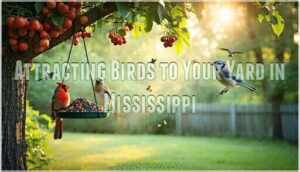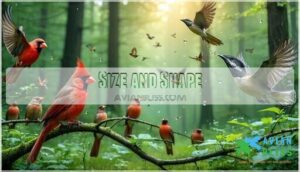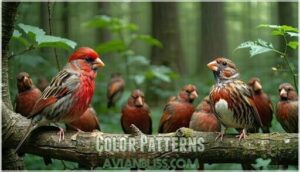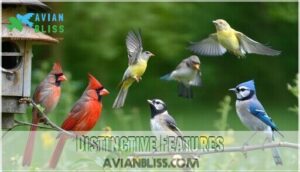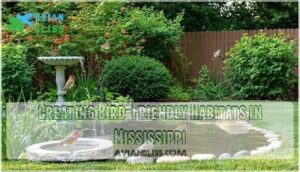This site is supported by our readers. We may earn a commission, at no cost to you, if you purchase through links.
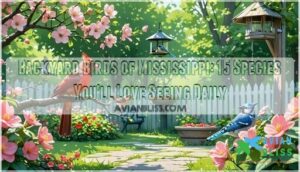
These feathered neighbors include Yellow-rumped Warblers during migration seasons and year-round residents like Northern Mockingbirds and Red-bellied Woodpeckers.
Your backyard becomes prime real estate when you understand what draws these species – from sunflower seeds that Cardinals can’t resist to the suet that keeps woodpeckers coming back.
Mississippi’s mild climate creates perfect conditions for both permanent residents and seasonal visitors.
The secret lies in knowing which birds prefer what food sources and shelter options during different seasons.
Table Of Contents
Key Takeaways
- You’ll attract the most common Mississippi backyard birds like Northern Cardinals and Blue Jays by offering black oil sunflower seeds, suet feeders, and fresh water sources in strategic locations near natural cover.
- You can identify birds quickly by focusing on distinctive features like the Cardinal’s bright red plumage, Blue Jay’s bold barring, and Red-bellied Woodpecker‘s zebra-striped wings combined with their unique behaviors and calls.
- You’ll create a thriving bird habitat by planting native fruiting trees like dogwood and elderberry, which provide natural food sources that outperform traditional feeders and support entire ecosystems.
- You can enhance your birding experience by using eBird to track Mississippi’s 410+ documented species and joining local Audubon Society groups for field trips, conservation projects, and expert identification tips.
Common Backyard Birds of Mississippi
You’ll find Mississippi’s backyard birds at your feeders year-round, with species like the bright red Northern Cardinal and boisterous Blue Jay among the most reliable visitors.
These common residents make up the core group of approximately 15 species that frequent residential areas throughout the state’s diverse habitats.
Northern Cardinal
The Northern Cardinal stands as Mississippi’s most beloved backyard resident, with males sporting brilliant red plumage that catches your eye instantly.
Mississippi’s crimson-crowned cardinals turn ordinary backyards into spectacular wildlife theaters year-round.
These year-round Mississippi bird species don’t follow traditional migration routes, making backyard birding rewarding throughout seasons.
You’ll notice distinct Cardinal Behavior as they crack sunflower seeds with powerful beaks, and their song patterns include clear whistles and chips, especially during dawn choruses.
Their Nesting habits involve dense shrubs where pairs raise multiple broods, and Feather care includes frequent preening to maintain their stunning appearance.
Attract them with platform feeders containing black oil sunflower seeds for ideal bird watching tips.
Blue Jay
Blue Jays bring vibrant energy to Mississippi’s backyard birding scene with their brilliant azure plumage and bold personalities.
These mississippi bird species showcase fascinating Blue Jay Behavior through their intelligence and social dynamics. You’ll often spot them in Jay Habitat areas like oak woodlands and suburban yards, where their distinctive calls echo through the trees.
- Jay Feeding: They’re omnivorous, eating acorns, insects, and occasionally small reptiles
- Feather Colors: Their blue isn’t actually blue pigment but light refraction through feather structure
- Bird Migration: Most Mississippi birds stay year-round, though northern populations migrate south
- Territorial Nature: They’ll mob predators and defend nesting areas aggressively against intruders
Yellow-rumped Warbler
Looking for movement in autumn trees? The yellowrumped warbler’s distinctive feather patterns make identification easy during warbler migration season.
These mississippi bird species arrive in September, transforming your backyard birds experience. Their varied bird diet includes insects and berries found on branches.
Winter habits keep them active in Mississippi’s mild climate. Bird watching in Mississippi becomes exciting when you spot their characteristic yellow patches.
Song patterns help distinguish them from other mississippi birds visiting your yard, making the warbler migration season and backyard birds experience more enjoyable with the presence of these mississippi birds.
Northern Mockingbird
Mississippi’s official state bird brings entertainment to your backyard with its impressive vocal talents.
The Northern Mockingbird can mimic over 200 different bird songs, creating a natural symphony that changes throughout the day.
These year-round residents defend their territory fiercely and adapt their diet seasonally.
They’re known for their ability to thrive in urban bird habitats, making them a common sight in many areas.
- Mockingbird Songs: Listen for rapid-fire medleys mixing cardinal whistles, crow calls, and even car alarms
- Nesting Habits: They’ll build multiple decoy nests to confuse predators while protecting their real clutch
- Feather Patterns: Watch for their distinctive white wing patches that flash dramatically during territorial displays
- Bird Migration: Unlike many Mississippi birds, mockingbirds stay put year-round, making them reliable backyard companions
Red-bellied Woodpecker
While mockingbirds serenade your yard, another performer awaits your attention—the Red-bellied Woodpecker. This Mississippi bird’s favorite sports zebra-striped wings and a bright red crown extending down its nape.
Despite its name, the red belly appears as subtle reddish patches. Redbellied Woodpeckers demonstrate fascinating pecking behavior, hammering tree bark for insects while their distinctive "churr-churr" woodpecker calls echo through neighborhoods.
Their woodpecker diet includes nuts, fruits, and insects. These backyard birds excel at acrobatic feeding, often hanging upside-down at suet feeders.
Bird watching enthusiasts appreciate their year-round presence and entertaining nesting habits in dead tree cavities.
Attracting Birds to Your Yard in Mississippi
You’ll find that establishing the right feeding stations and habitat features transforms your Mississippi backyard into a reliable bird observation site.
Strategic placement of black oil sunflower seed feeders and native fruiting plants attracts year-round residents like Northern Cardinals and seasonal visitors throughout the year.
Bird Feeders
Strategic bird feeders transform your Mississippi backyard into a bustling avian highway. Position multiple feeder designs near natural cover like shrubs or trees, giving birds quick escape routes from predators. Different seed types attract various species, while proper feeding strategies guarantee year-round visits from cardinals, woodpeckers, and finches.
Turn your yard into a bird paradise with strategic feeders and native plants that welcome feathered friends year-round.
Understanding urban bird foraging helps you choose the right foods for your feeders.
Essential feeder types for maximum bird attraction:
- Tube feeders – Perfect for black oil sunflower seeds and mixed birdseed
- Platform feeders – Ideal for ground-feeding species like cardinals and jays
- Suet feeders – Critical for attracting woodpeckers during winter months
- Hopper feeders – Weather-protected feeding for multiple Mississippi birds simultaneously
- Nyjer feeders – Specifically target finches and smaller backyard birds
Clean feeders regularly to prevent disease transmission.
Hummingbird Feeders
While seed feeders attract many Mississippi birds, hummingbird feeders bring ruby-throated hummingbirds to your backyard.
Mix one part white sugar with four parts water for perfect nectar recipes. Skip red dye—it’s unnecessary and potentially harmful.
Smart feeder placement involves hanging feeders in partial shade near native flowering plants. Change sugar water every three to four days in hot weather for proper feeder maintenance.
Clean weekly with hot water and white vinegar to prevent mold. Multiple hummingbird feeders reduce territorial disputes among these tiny acrobats.
These specialized bird feeders complement your existing setup, creating a thorough bird watching experience that attracts diverse backyard birds throughout Mississippi’s growing season. Using proper hummingbird feeders is essential for maintaining a healthy hummingbird population.
Food Sources
Smart food choices transform your backyard into a bustling bird buffet. Different Seed Types attract specific species, while quality birdseed guarantees consistent visits. Black oil sunflower seeds remain the gold standard for most Mississippi birds.
- Suet Feeders: Draw woodpeckers, nuthatches, and chickadees with high-energy fat cakes
- Sunflower seeds: Attract cardinals, blue jays, and finches to your Bird Feeders
- Peanuts: Entice jays and woodpeckers with protein-rich Nut Offers
Fresh, diverse food sources keep birds returning daily to your feeding stations. Understanding urban bird feeding practices can help you create a more effective bird-friendly environment.
Fruit-bearing Plants
Native shrubs and fruit trees create a natural buffet that Mississippi birds can’t resist.
Berry selection matters – elderberries, serviceberries, and native blackberries attract Eastern Bluebirds, Northern Mockingbirds, and American Robins throughout the year.
Garden planning should include diverse fruiting plants that ripen at different times, ensuring consistent bird feeding opportunities.
Plant diversity strengthens bird attraction by providing various food sources when traditional birdseed runs low.
Native plants like wild grapes and dogwood berries support local ecosystems while drawing dozens of species to your backyard paradise.
By incorporating native plants that provide native food sources into your garden, you can create a thriving habitat for local bird species.
Nut-bearing Plants
Beyond berry bushes, nut-bearing trees create backyard bird magnets that’ll keep your feathered friends happy year-round.
Pecan Trees and Walnut Planting provide high-energy food sources that native plants-loving mississippi birds crave more than basic sunflower seeds from standard bird feeders.
Smart backyard birds like Blue Jays cache nuts for winter survival.
Consider these powerhouse options:
- Pecan Trees – attract woodpeckers and nuthatches
- Hazelnut Care requires minimal maintenance for maximum bird appeal
- Pine Nut producing trees feed chickadees and titmice
- Chestnut Growth supports diverse species populations
These trees outperform typical feeders by offering natural foraging experiences.
Nectar Plants
Hummingbirds and other Mississippi birds crave natural nectar sources throughout the growing season.
Your flower choices matter when selecting pollinator plants that deliver consistent sugar water alternatives.
Native plants like cardinal flower, bee balm, and wild bergamot create reliable nectar sources for backyard birds.
These blossom types bloom at different times, ensuring continuous feeding opportunities.
Red tubular flowers attract hummingbirds, while flat-topped blooms like Joe Pye weed appeal to various species.
Plant clusters of the same variety for maximum visual impact and efficient bird feeding access, and to create a reliable nectar source.
Shelter and Cover
Several strategic elements create ideal bird habitats in your Mississippi backyard.
Dense garden shrubs and native trees provide essential cover from predators and harsh weather.
Fence rows offer natural corridors for bird movement, while brush piles give ground-dwelling species quick escape routes.
These diverse shelter options attract various backyard birds by meeting their instinctual needs for security and protection, providing them with essential cover.
Nest Boxes
Setting up bird nesting boxes opens doors to fascinating backyard wildlife encounters.
Proper nest box designs attract cavity-nesters like Eastern Bluebirds, Carolina Chickadees, and Downy Woodpeckers to your Mississippi landscape.
Strategic box placement—facing away from prevailing winds and predator access—ensures successful bird nesting seasons.
Clean out old nest materials annually to prevent nest parasites from establishing.
Consider adding roosting boxes for winter shelter.
These backyard birds reward your efforts with delightful spring activity as parents feed hungry fledglings throughout Mississippi’s breeding season.
Using the right bird nesting materials is vital for the birds’ safety and well-being.
Fresh Water
Clean water transforms your yard into a magnet for Mississippi birds seeking hydration and bathing opportunities.
Freshwater birds like herons occasionally visit backyard water sources, while common Mississippi wildlife depends on reliable aquatic access.
Place shallow dishes with fresh sources of clean water near feeders to maximize attraction.
Key water features for backyard birds:
- Water Quality – Change water every 2-3 days to prevent algae
- Shallow depth – Keep water 1-2 inches deep for safety
- Textured surfaces – Add pebbles for secure footing
- Moving water – Drippers attract more bird species
- Winter access – Use heated birdbaths during cold spells
Identifying Birds in Mississippi
You’ll master bird identification by observing four key characteristics: size and shape, color patterns, behavior, and distinctive features like bill shape or tail length.
Start with common species like the bright red Northern Cardinal or the blue-crested Blue Jay, then practice recognizing subtle differences between similar birds like the Downy and Hairy Woodpeckers, focusing on distinctive features.
Size and Shape
Bird watchers discover identification secrets through careful observation of size and shape fundamentals.
Body proportions reveal lifestyle clues—compact songbirds versus elongated raptors tell different stories.
Wing span indicates flight patterns, while feather length suggests habitat preferences.
Beak shapes mirror feeding habits perfectly.
Study bird silhouettes against Mississippi’s sky to distinguish backyard birds quickly.
These physical markers help separate similar bird species during identification sessions.
Master these basics before diving into color patterns for thorough bird watching success with careful observation.
Color Patterns
Most backyard birders discover that mastering color patterns reveals the secret to quick bird identification.
You’ll notice distinct Plumage Variations across different body regions—head, back, belly, wings, and tail areas each tell their own story.
Focus on these key identification markers:
- Head patterns: Northern Cardinal males display brilliant red crests, while Carolina Chickadee shows black caps with white cheeks
- Wing Markings: Blue Jay features distinctive blue and white striped wings that catch sunlight beautifully
- Beak Patterns: American Goldfinch sports a bright orange-yellow bill during breeding season
- Tail Shades: Eastern Bluebird males flash royal blue tail feathers with subtle darker edges
Feather Colors change seasonally, so you’ll spot different variations throughout the year. These visual cues become your field guide compass.
Behavior
Watching bird behavior reveals each species’ personality and helps you identify Mississippi birds with confidence.
Cardinals hop boldly on the ground while Blue Jays swagger through branches with territorial confidence. Observe their foraging strategies – woodpeckers spiral up tree trunks, while finches dangle acrobatically from seed heads.
Mating habits vary dramatically, from mockingbirds’ elaborate song performances to cardinals’ gentle beak-touching courtship. Flocking patterns change seasonally – solitary nesters become gregarious winter survivors.
Nesting behavior offers identification clues too. Some birds prefer high canopies while others choose low shrubs. Understanding bird social structures is essential for recognizing these patterns. These behavioral differences make backyard bird watching an engaging detective game year-round.
Distinctive Features
Studying distinctive features reveals bird identification like finding keys to nature’s secrets.
Focus on beak shapes first—Northern Cardinals sport thick, seed-cracking bills while Carolina Chickadees have tiny, insect-grabbing beaks.
Feather patterns reveal identity clues: Blue Jays display bold black barring, American Goldfinches show bright yellow plumage colors during breeding season.
Wing structures help separate similar species.
Brown Thrashers have rusty streaks throughout their bodies.
Bird songs provide final confirmation when visual features aren’t enough for certain identification.
EBird and Birding Communities in Mississippi
You’ll find eBird serves as Mississippi’s most exhaustive bird tracking platform with over 410 documented species across the state.
Joining local birding groups through the Mississippi Audubon Society connects you with experienced birders who share county-specific sighting data and organize regular field trips to prime locations like Ward Bayou Wildlife Management Area, which is a key spot for bird tracking.
Using EBird for Bird Sightings
Digital technology transforms how you track Mississippi birds through eBird, the world’s largest biodiversity citizen science project.
Create detailed checklists by recording species, counts, and locations during your backyard bird watching sessions.
The platform’s sightings data reveals seasonal bird trends and migration patterns specific to your county.
Interactive species mapping shows which backyard birds appear most frequently in your area.
Study recent reports before heading outdoors to discover prime locations for bird identification.
This bird tracking system helps you build thorough life lists while contributing valuable data to ornithological research and supports the creation of detailed checklists.
Joining Local Bird Groups
Beyond solo observations, Mississippi’s birdwatching communities offer rich connections with fellow enthusiasts who share your passion for avian discovery.
The Mississippi Audubon Society hosts regular local meetings where you’ll swap stories, compare field notes, and plan upcoming adventures.
Join these vibrant birdwatching groups to enhance your backyard birding experience:
- Birding Events – Weekly walks through Mississippi birding trails reveal species you’ve never noticed
- Volunteer Opportunities – Assist with bird conservation projects and habitat restoration efforts
- Community Outreach – Share knowledge with newcomers while learning from seasoned birdwatchers
- Birdwatching Organizations – Connect with statewide networks that organize field trips and workshops
Accessing County-specific Data
After connecting with local bird groups, you’ll want to tap into eBird’s county-specific data for deeper insights into mississippi bird species. These detailed county maps reveal which mississippi birds call your exact area home throughout the year.
eBird’s county atlases transform casual backyard birds watching into serious data analysis. You can explore distribution maps for every recorded species, view bar charts showing seasonal abundance, and discover nearby birding hotspots. Compare your local geographic trends to statewide patterns while tracking species that breed, winter, or migrate through your county.
This county-level species tracking helps you contribute meaningful bird surveys data as a citizen scientist:
- Discover rare mississippi wildlife visitors you never knew existed nearby
- Time your yard setup perfectly for peak migration periods
- Connect with neighbors who’ve spotted your target bird species lists
- Feel the thrill of contributing to scientific bird species research
- Build confidence identifying subtle regional variations in common species
Creating Bird-Friendly Habitats in Mississippi
You’ll transform your yard into a thriving bird habitat by understanding what Mississippi’s 426+ species need for survival and reproduction.
Creating diverse vegetation layers with native fruiting trees and providing fresh water sources attracts more bird species than standard feeders alone, which can be considered a thriving addition to any yard.
Importance of Habitat
Your backyard becomes a bird magnet when you create the right habitat.
Habitat diversity drives bird populations more than feeders alone.
Native plants form the backbone of successful bird conservation efforts, providing natural food sources and nesting materials.
Tree canopy coverage offers essential shelter from predators and weather extremes.
Mississippi bird sanctuaries demonstrate how thoughtful urban planning supports ecosystem balance.
You’ll notice more species when your yard mimics natural environments.
Dead snags provide nesting cavities for woodpeckers, while dense shrubs shelter ground-feeding birds.
Even small changes make big differences.
Skip the perfectly manicured lawn approach.
Birds prefer messy edges with varied vegetation heights.
Your bird habitat becomes self-sustaining when native plants attract insects that feed songbirds year-round.
Backyard bird feeders supplement this natural system perfectly.
By incorporating a bird friendly habitat design, you can substantially enhance the biodiversity in your yard.
Attracting Common Birds
Several strategic approaches transform your yard into a Mississippi bird magnet. Creating diverse feeding stations with different feeder types guarantees you’ll attract cardinals, blue jays, and woodpeckers simultaneously.
Your yard layout should include both open spaces and dense cover areas where birds feel secure.
- Position backyard bird feeders near natural cover but maintain clear sightlines
- Offer varied bird seed types including sunflower, millet, and nyjer
- Install multiple water sources at different heights for drinking and bathing
- Plant native garden plants that provide natural food sources
- Avoid pesticides that harm insects birds depend on for protein
Planting Native Fruiting Bushes and Trees
Native fruit trees like dogwood and elderberry create natural buffets for Mississippi backyard birds.
These bird friendly shrubs outperform traditional feeders by supporting entire ecosystems.
Plant American beautyberry and hackberry for year-round sustenance.
Native habitat restoration through fruiting bush care attracts 530% more species than non-native alternatives.
Your wild birds will thank you for the year-round sustenance.
Utilizing EBird for Species Information
Through eBird’s extensive platform, you’ll discover Mississippi’s incredible avian diversity with over 410 documented species.
This citizen science tool transforms your backyard observations into valuable conservation data while connecting you to a global community of bird enthusiasts.
- Track real-time bird sightings across Mississippi counties
- Access detailed species maps showing seasonal distribution patterns
- Document your personal birding journey with digital checklists
- Contribute to scientific research through biodiversity monitoring
- Discover rare species alerts in your local area
eBird data empowers both novice and experienced birdwatchers to participate in meaningful species tracking efforts.
Joining a Local Bird Club
Beyond tracking species digitally, connecting with Mississippi’s bird watching community opens doors you never knew existed.
Local bird watching clubs offer membership types ranging from casual participants to dedicated volunteers who lead field trips along Mississippi birding trails.
| Club Benefits | Details |
|---|---|
| Local Meetings | Monthly gatherings with expert speakers and identification workshops |
| Field Trips | Guided excursions to prime birdwatching locations across Mississippi |
| Conservation Projects | Hands-on habitat restoration and citizen science initiatives |
The Mississippi Audubon Society hosts regular events where seasoned birders share secrets about attracting Northern Cardinals and Blue Jays to backyard feeders.
You’ll discover volunteer opportunities that directly support bird conservation efforts while building friendships with fellow enthusiasts.
These connections transform solitary birdwatching into shared adventures.
Members exchange tips about creating bird-friendly gardens and report exciting sightings from their neighborhoods.
The birdwatching in Mississippi community welcomes newcomers with open arms and binoculars ready.
Frequently Asked Questions (FAQs)
When do most birds migrate through Mississippi?
You’ll catch Mississippi’s feathered freeloaders during spring (March-May) and fall (September-November) migrations.
These seasonal commuters use the Mississippi Flyway as their highway, timing their journeys with favorable weather and food availability.
What threats do backyard birds face?
Your backyard birds face multiple dangers daily.
Cats kill billions annually, while window strikes cause countless deaths.
Habitat loss, pollution, climate change, and invasive species threaten their survival and disrupt natural feeding patterns.
How do seasons affect bird populations?
Like nature’s own seasonal theater, bird populations ebb and flow with Mississippi’s changing climate.
You’ll notice fewer species during winter months, while spring and fall migrations bring diverse visitors to your feeders and gardens.
Which birds are considered invasive species?
European Starlings and House Sparrows top Mississippi’s invasive bird list.
You’ll spot these aggressive species bullying native birds at feeders.
Brown-headed Cowbirds also cause problems by laying eggs in other birds’ nests, and are thus considered invasive species that can be very aggressive.
What conservation efforts protect Mississippi birds?
Over 400 bird species call Mississippi home, and you’ll find multiple conservation efforts protecting them.
The Mississippi Department of Wildlife leads habitat preservation, while community science databases like eBird help track population trends for better protection.
Conclusion
Building your backyard birding paradise proves the old saying "if you build it, they’ll come" rings true for Mississippi’s feathered residents.
You’ve learned which seeds attract Cardinals, how suet draws woodpeckers, and why fresh water sources remain essential year-round.
These backyard birds of Mississippi reward your efforts with daily entertainment and natural pest control.
Start with basic feeders and native plants, then watch as fifteen species transform your outdoor space into a thriving avian community that’ll keep you captivated throughout every season.
- https://www.mdwfp.com/sites/default/files/2024-03/mississippi_swap_revised_16_september_2016__reduced_.pdf
- https://www.pnas.org/doi/10.1073/pnas.2110156119
- https://www.frontiersin.org/journals/environmental-science/articles/10.3389/fenvs.2024.1401513/full
- https://www.nature.com/articles/s41598-022-16406-w
- https://www.tandfonline.com/doi/full/10.1080/00063657.2018.1446903



